A tree nursery is a place where young trees are propagated and grown to a size where they can be transplanted elsewhere. Growing trees in nurseries for reforestation is not a new concept.
Ancient cultures were engaged in this activity. One of the earliest accounts of reforestation occurred during Pharaoh Ptolemy’s reign when he established plantations of fast-growing trees along the fertile bottomlands of the Nile River in response to a growing shortage of lumber. This practice was so successful that Egypt had a glut of timber for a number of centuries.
Many cultures in Europe, especially the Nordic people, developed crude nurseries for reforestation. When the colonists came to America they spent many years clearing the massive forests found in the eastern half of the country, but soon they were growing fruit trees and nut producers.
A large grove of oak trees was established in Massachusetts in the 1840s, according to a historical account. In 1895 the beginnings of professional forestry and cultivation of tree nurseries was initiated at the Biltmore Estate of George Vanderbilt in Asheville, North Carolina. Vanderbilt hired foresters trained in Germany such as Gifford Pinchot and Carl Scheneck to manage the forests of the estate. Scheneck was instrumental in developing one of the first intensive tree nurseries in the country.
 During roughly the same time period Dr. Charles E. Bessey, professor of botany and horticulture at the University of Nebraska, began experimenting with the planting of a number of tree species on a tract of land owned by the university. Dr. Bernard Fernow who was the head of the Division of Forestry in Washington, D.C., learned of Bessey’s field trials and began sending him seeds to grow a number of tree species. Soon thereafter the first Federal Tree Nursery was established in Halsey, Nebraska.
During roughly the same time period Dr. Charles E. Bessey, professor of botany and horticulture at the University of Nebraska, began experimenting with the planting of a number of tree species on a tract of land owned by the university. Dr. Bernard Fernow who was the head of the Division of Forestry in Washington, D.C., learned of Bessey’s field trials and began sending him seeds to grow a number of tree species. Soon thereafter the first Federal Tree Nursery was established in Halsey, Nebraska.
Fred Besley, the eventual originator of the Maryland Forest Service, was employed as the superintendent of the Federal Tree Nursery in 1904. In 1906 forester Besley was hired as the first state forester with the Maryland Forest Service. The Maryland legislature passed the Roadside Tree Law in 1914 which was considered landmark legislation for its time. This law gave the Maryland Forest Service the authority to plant, care for, and protect trees along public roads and rights of ways.
Soon after the law was passed the first tree nursery was established on the campus of the University of Maryland in College Park. Eventually three separate tracts were planted on the campus to grow trees for different purposes. Scientific study of growing trees began and eventually led to a national Tree Improvement Program.
Using this method, tree genetics were used to develop superior growing stock. Genetically superior seed was collected and seed orchards were established to grow these desirable trees alongside other trees with similar traits to develop and harvest superior seed stock. The Beltsville Experimental Nursery began in response to these breeding experiments.
In 1949 the Maryland Tree Nursery was moved from College Park to Harmons and named the Buckingham State Tree Nursery. In 1996 the State Tree Nursery moved to its current location outside of Preston on the Eastern Shore. At present, the John S. Ayton Tree Nursery occupies nearly 300 acres and grows about 8 million seedling-sized trees per year for conservation purposes.
This year the nursery has offered nearly 70 different varieties of deciduous and evergreen species for sale. The nursery begins its sales in October and will curtail around May. For more information on the John S. Ayton Tree Nursery you can call 1-800-873-3763 or visit their web site.
Back to Feature Stories